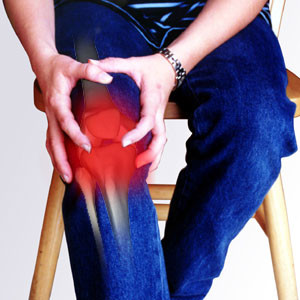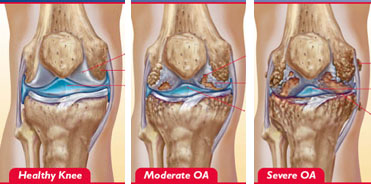Have you ever gotten up from bed in the morning only to find that your knees are stiff as a board, especially when it’s a cold morning? Heard clicking noises (also known as crepitus) or felt a grinding sensation coming from your knee joints when you move them? Getting sharp pains in the knee joints when you get up from squatting when gardening or bathing your pet? Chances are, you might be suffering from a degenerative condition called ‘osteoarthritis’ which can affect not only the knees but any joint in your body. The article today will be covering the cause, symptoms and treatment of knee osteoarthritis
What is osteoarthritis, you may ask? Let us break up this big word to two simple terminologies namely “osteo” from the Greek word “osteon” which means bone and “arthritis” which means joint inflammation. Simply put, osteoarthritis is a wear and tear arthritis that the natural covering of the joints called articular cartilage between the joints wears away due to the change in structure within the joint. This happens when the ends of the two bones, femur (thigh bone) and tibia (shin bone), rub more closely against one another due to external factors that can cause it. Not to be confused with and unlike Rheumatoid arthritis, osteoarthritis sufferers will feel better during a rested period and worse with excessive use.
A Community Oriented Program for Control of Rheumatic Diseases (COPCORD) survey which was conducted in Malaysia back in 2007 found most osteoarthritis sufferers in Malaysia have knee osteoarthritis, which correlated with another study conducted in Hong Kong. The study also found that most Malaysians aged 55 years complained that the rate of pain increased to 23% whilst a 39% increase of pain rate was found in those over 65 years.
Almost everyone has a risk of getting osteoarthritis but studies conducted in Pakistan, China, Korea and Japan have concluded that women, older age groups and people who are obese have a higher risk of getting knee osteoarthritis. So what about the fabled myth that kneeling and squatting may cause osteoarthritis in the knees? Researchers in Japan have found that excessive squatting and kneeling especially during gardening can indeed cause permanent knee damage.
So what are the preventive measures to prevent osteoarthritis in the knees? The most effective way to have a healthy set of knees is to control your weight and to do that you need to exercise on a regular basis. Go out for morning walks or better yet, have 30 minutes of swimming sessions in a nearby pool. It helps to tone up muscles in the knees that will effectively strengthen the weight bearing joints and helps to avoid putting excessive pressure on them. If you are obese and unsure on what exercises to do or experiencing pain in the knees while exercising, do consult a medical professional as soon as possible. Remember, osteoarthritis is degenerative disease and once you get it, the condition will worsen over time. Therefore, early action is important, do not let knee osteoarthritis bring you to your knees.
Mr. Jonathan Goh is a physiotherapist currently working in Sarawak. He is passionate about increasing public awareness on important issues such as osteoarthritis.
References
- http://www.copcord.org/Publications/Malaysia%20%20copcord.pdf
- http://www.ncbi.nlm.nih.gov/pubmed/4703218
- Gibson T, Hameed K, Kadir M, Sultana S, Fatima Z, Syed A (1996) Knee pain amongst the poor and affluent in Pakistan. Br J Rheumatol 35, 146–9.
- Zeng QY, Zang CH, Li XF, Dong HY, Zhang AL, Lin L(2006) Associated risk factors of knee osteoarthritis: a population survey in Taiyuan, China. Chin Med J 119,1522–7
- Kim I, Kim HA, Se Y-I, Song YW, Jeong J-Y, Kim DH (2010) The prevalence of knee osteoarthritis in elderly community residents in Korea. J Korean Med Sci 25, 293–8.
- Muraki S, Oak H, Akune T, et al. (2009) Prevalence of radiographic knee osteoarthritis and its association with knee pain in the elderly of Japanese population-based cohorts: the ROAD Study. Osteoarthr Cartil 17, 1137–43.
[This article belongs to The Malaysian Medical Gazette. Any republication (online or offline) without written permission from The Malaysian Medical Gazette is prohibited.]



What are your thoughts about electrotherapy for treating knee osteoarthritis?
Greetings Greg! First of let us discuss what does electrotherapy treatment do to the body. For example of a man who just got kicked in the shin and his first reaction is to apply a rapid upwards and downwards friction massage on the injured area. We do this because we apply a different and stronger sensation on our skin that “covers” the feeling of intense pain. Electrotherapy does this. The problem I see with purchasing this to treat your knee is that it will be suppressing the pain which by the way is our body’s way of telling us something is wrong. It may solve your pain but it would not fix what is causing the problem that is causing it. It may end up getting worst without you knowing it. So do have a consult with a medical professional to see what is exactly causing the pain first and get the proper treatments done. Hope this helps Greg! let me know if you need further advice. I would be happy to help.
P.S I would like to advise believing that “electrotherapy is a great alternative to knee replacement surgery”. As I have discussed in my article, Knee Osteoarthritis is change in the structure of the knee which causes friction of the surface of the femur and tibia bones. That said, how does one treat it with a neuro-modulation aka reduction of pain via electro-treatment.
Hi Mr Jonathan. As you said that electrotherapy is unlikely a better alternative for knee replacement, can it be used to relieve the pain on the basis that it may suppress the pain sensation (pain gate theory)?
Greetings doc, I’m experiencing a very severe pain at my joints every time I bend my knees or even if I just sit on a chair for hours. I need to straightened my legs first before I can start walking right after that. Is it normal or a sign of arthritis? I’m just 20! Helppppp
Hi there. I’m not authorised to reply on behalf of the writer. However, as a physiotherapist I’m strongly advice for you to consult a medical practitioner as it is difficult to make diagnosis without having adequate tests.
Thanks.